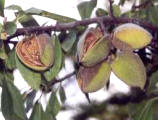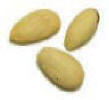Almonds
Information about Almonds plus Almond recipes
collection
Â
|
Ingredient
of the
MonthÂ
|
Scroll
down for Almond Recipes
|
AprilÂ
2005 |
Click
here for more Ingredients
Â
Â
 Almonds
are a fruit which belong to the Prunus family which includes other fruit
such as plum, cherry and peach. There are two types - sweet almonds (prunus
amygdalus �dulcis�) which are are the ones used for culinary purposesÂ
and bitter almonds (prunus amygdalus �amara�) which, because they have
poisonous properties, are mainly processed and used in the making of oils or
flavourings such as almond essence. One way or another, this universal nut is
used in most countries. Almonds
are a fruit which belong to the Prunus family which includes other fruit
such as plum, cherry and peach. There are two types - sweet almonds (prunus
amygdalus �dulcis�) which are are the ones used for culinary purposesÂ
and bitter almonds (prunus amygdalus �amara�) which, because they have
poisonous properties, are mainly processed and used in the making of oils or
flavourings such as almond essence. One way or another, this universal nut is
used in most countries.
Â
Almonds Origin
and History Almonds
Â
Although almonds are thought
to have originated in western or central Asia, Â by
4000BC they had spread extensively and
have been widely used for both culinary and other purposes for thousands of
years.Â
By the late 700
AD Arab traders who by now had set up regular trade with Spain and Portugal
introduced the almond tree to those countries and almonds are still a popular
ingredient in both cuisines. They were introduced to Northern India in the 16th
century by Persians immigrants who settled in the region and as with Portugal
and Spain, almonds are now an established ingredient in some North Indian
cuisines in particular the Mughlai style of cooking.
Â
During the Middle Ages,
almonds were an important trading commodity in Europe as their consumption in
medieval cookery rocketed. Recipes using almond "flour" dating from
this period have been found and almond "milk" was used as a substitute for
milk on religious fasting days. In the 1700's Franciscan monks transported
almond trees from Spain to California and today US almond growers supply more
than 75 percent of worldwide production.
Â
Cultivation
and Processing Almonds
Â
 The
almond tree is a very pretty tree and is one of the first fruit trees to blossom
in Spring. Because of this, it has been regarded through the ages by many
cultures as a bringer of new life and fertility. It's a relatively a small tree
growing to about 30 feet high, with the fruit forming singly and in clusters on
the branches. The
almond tree is a very pretty tree and is one of the first fruit trees to blossom
in Spring. Because of this, it has been regarded through the ages by many
cultures as a bringer of new life and fertility. It's a relatively a small tree
growing to about 30 feet high, with the fruit forming singly and in clusters on
the branches.
Â
A natural draw-back of the early flowering means that the tree
needs a warm dry climate in order to produce well. It will survive in more
temperate climates, such as that in the south of the UK although fruit
production will be inferior. Almond tree are not self-pollinating so at
least two different varieties of trees are necessary. Many almond orchards have
beehives in place to assist with the pollination.
Â
Once the fruit set, the hulls start to harden until they
eventually begin to split around 4 months later. When the fruit is fully
mature, the hulls completely burst open exposing the shell allowing the kernel
(nut) to begin drying out. Mechanical tree "shakers" are sometimes utilised to
harvest the nuts although hand harvesting is also done by means of knocking the
fruit from the branches with long poles. Once on the ground they are allowed to
dry before being taken to a hulling facility where the nuts are removed from the
outer casing (hulls). The nuts are then either transported for sale whole
or taken for further processing i.e. to be shelled, blanched, chopped or ground.
Buying, storing and preparing Almonds
For culinary purposes, Almonds can be purchased in a number of forms e.g.Â
whole in shell, whole in skin, whole blanched, flaked, slivered and
ground not to mention as a flavouring (essence). when buying them in shell
a good test as to the freshness is buy shaking them. If they rattle a lot it's a
sign that the nut is shrinking and is therefore aging.
|

 Almonds
are a fruit which belong to the Prunus family which includes other fruit
such as plum, cherry and peach. There are two types - sweet almonds (prunus
amygdalus �dulcis�) which are are the ones used for culinary purposesÂ
and bitter almonds (prunus amygdalus �amara�) which, because they have
poisonous properties, are mainly processed and used in the making of oils or
flavourings such as almond essence. One way or another, this universal nut is
used in most countries.
Almonds
are a fruit which belong to the Prunus family which includes other fruit
such as plum, cherry and peach. There are two types - sweet almonds (prunus
amygdalus �dulcis�) which are are the ones used for culinary purposesÂ
and bitter almonds (prunus amygdalus �amara�) which, because they have
poisonous properties, are mainly processed and used in the making of oils or
flavourings such as almond essence. One way or another, this universal nut is
used in most countries. The
almond tree is a very pretty tree and is one of the first fruit trees to blossom
in Spring. Because of this, it has been regarded through the ages by many
cultures as a bringer of new life and fertility. It's a relatively a small tree
growing to about 30 feet high, with the fruit forming singly and in clusters on
the branches.
The
almond tree is a very pretty tree and is one of the first fruit trees to blossom
in Spring. Because of this, it has been regarded through the ages by many
cultures as a bringer of new life and fertility. It's a relatively a small tree
growing to about 30 feet high, with the fruit forming singly and in clusters on
the branches.


